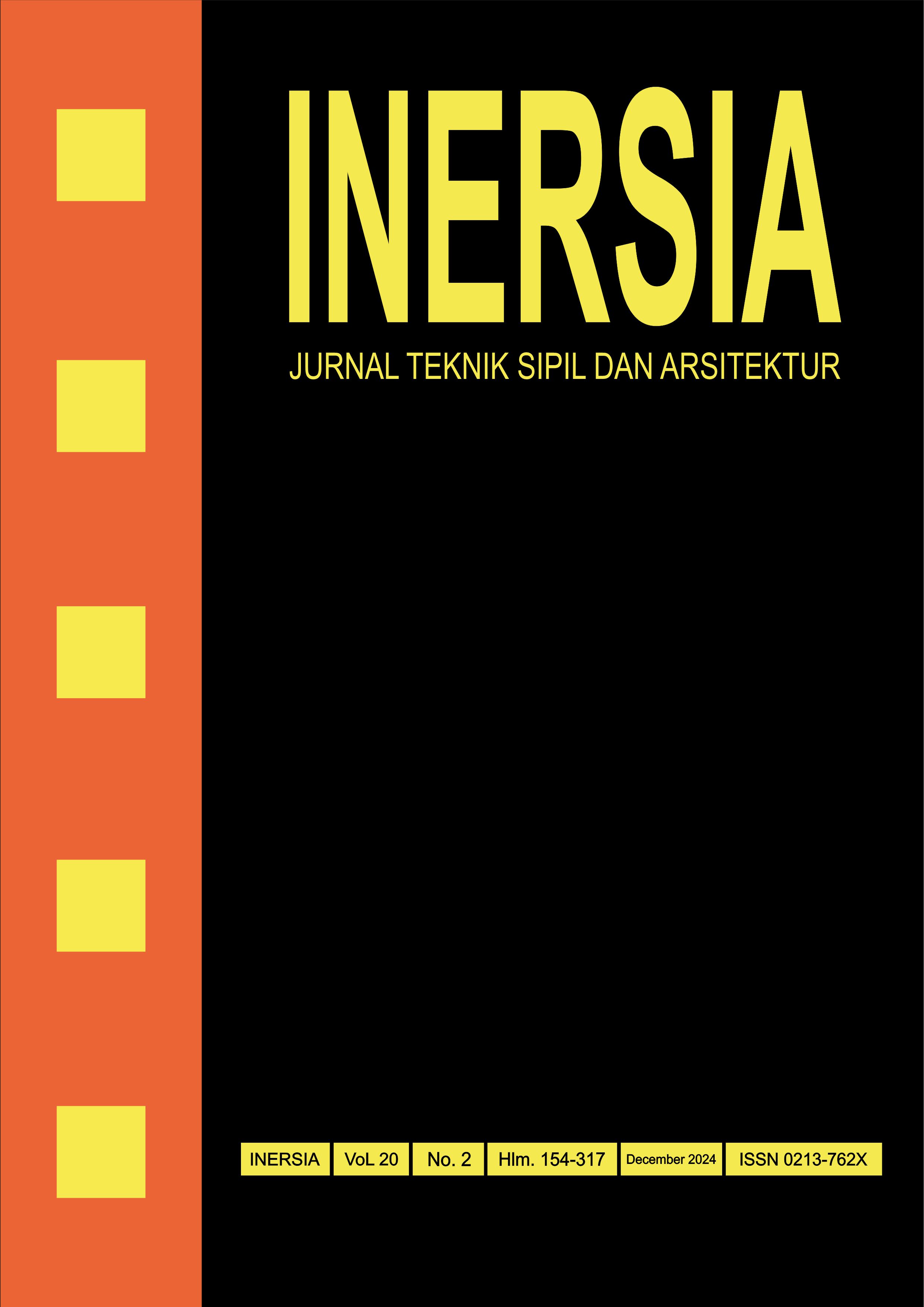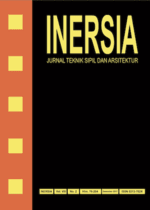Analysis of the Comparison Between Residents' Perception and Field Measurement of Visual and Thermal Comfort (Case Study: Student Dormitory Building)
DOI:
https://doi.org/10.21831/inersia.v20i2.77370Keywords:
Visual Comfort, Thermal Comfort, Lighting Level, Air Temperature, Humidity.Abstract
As public buildings, student dormitories must be comfortable as they host most of the students' lives and activities. A space's visual and thermal comfort significantly impacts the occupants' activities and productivity. Indicators for assessing the building comfort level include visual, thermal, and noise comfort in spaces or buildings. This paper presents the results study of the building's visual and thermal comfort measurement and the occupants' perception toward comfort. This paper also presents the comparison between that measurement and the occupants' perceptions. This research employs a mixed-methods approach consisting of qualitative methods (occupants' perception questionnaire) and quantitative methods (field measurements of lighting levels, air temperature, and humidity). Data were collected through questionnaires distributed to dormitory residents and field measurements using an Environmental Meter 4 in 1 to measure natural and artificial lighting levels, air temperature, and humidity. The data obtained were analyzed and then presented in a descriptive format. Based on residents' perceptions, the findings indicate that the overall visual and thermal comfort in the dormitory building falls within a good category. The field measurements on natural lighting, air temperature, and humidity show that the student dormitory building meets the established comfort standards. However, the artificial lighting of staircases and corridors doesn't meet the standards due to many non-functioning lights and low lumen levels. Overall, the lighting, temperature, and humidity conditions in the dormitory building are influenced by building design, orientation, surrounding environment, and occupants' behavior. To enhance comfort and health for residents, improvements in artificial lighting systems, enhancement of natural ventilation, and education on the importance of good air circulation are necessary.
References
A. Pradipta, S. B. M. Tarigan, and J. W. Usop, "Kriteria Bangunan Asrama Mahasiswa di Universitas Palangka Raya Dengan Pendekatan Arsitektur Modern," TRANSFORM: Journal of Tropical Architecture and Sustainable Urban Science, vol. 2, no. 1, pp. 104–115, 2023. https://doi.org/10.30872/transform.v2i1.376
T. I. Praganingrum, N. L. M. A. M. Pradnyadari, and N. N. I. S. Saraswati, "Keandalan Bangunan Gedung Pasar Rakyat Tematik Wisata Ubud," Ganec Swara, vol. 17, no. 4, p. 1912, Dec. 2023, doi: 10.35327/gara.v17i4.650.
A. R. Adji, "Kajian Kenyamananan Visual Melalui Pencahayaan Pada Ruang Kerja," Jurnal Arsitektur ARCADE, vol. 6, no. 1, p. 135, Apr. 2022, doi: 10.31848/arcade.v6i1.841.
N. A. Putri, R. Hermawan, and L. Karlinasari, "Measuring thermal comfort in a built environment: A case study in a Central Business District, Jakarta," IOP Conf Ser Earth Environ Sci, vol. 918, no. 1, p. 012024, Nov. 2021, doi: 10.1088/1755-1315/918/1/012024.
M. Muhaimin, "Urgensi Kenyamanan Termal dalam Perspektif Pembelajaran," Geodika: Jurnal Kajian Ilmu dan Pendidikan Geografi, vol. 7, no. 1, pp. 23–32, Jun. 2023, doi: 10.29408/geodika.v7i1.6451.
X. Sun, H. Wu, and Y. Wu, "Investigation of the relationships among temperature, illuminance and sound level, typical physiological parameters and human perceptions," Build Environ, vol. 183, p. 107193, Oct. 2020, doi: 10.1016/j.buildenv.2020.107193.
N. Abdollahzadeh, A. V. Farahani, K. Soleimani, and Z. S. Zomorodian, "Indoor environmental quality improvement of student dormitories in Tehran, Iran," International Journal of Building Pathology and Adaptation, vol. 41, no. 1, pp. 258–278, Mar. 2023, doi: 10.1108/IJBPA-09-2021-0128.
A. Ashadi and A. Anisa, "Konsep Disain Rumah Sederhana Tipe Kecil Dengan Mempertimbangkan Kenyamanan Ruang," NALARs, vol. 16, no. 1, p. 1, Feb. 2017, doi: 10.24853/nalars.16.1.1-14.
I. Vicaningrum and S. R. Marcillia, "Optimalisasi Pencahayaan Alami Terhadap Kenyamanan Visual: Simulasi Ruang Studio Arsitektur Menggunakan Geolokasi EPW D.I. Yogyakarta," Arsir, vol. 8, no. 1, pp. 92–105, May 2024, doi: 10.32502/arsir.v8i1.154.
M. R. Pahlevi and M. Muliadi, "Analisis dan Desain Tingkat Pencahayaan Pada Ruang Perpustakaan Universitas Iskandar Muda," Jambura Journal of Electrical and Electronics Engineering, vol. 4, no. 2, pp. 196–201, Jul. 2022, doi: 10.37905/jjeee.v4i2.14501.
A. Ratnasari and I. S. Asharhani, "Aspek Kualitas Udara, Kenyamanan Termal Dan Ventilasi Sebagai Acuan Adaptasi Hunian Pada Masa Pandemi," Arsir, p. 24, Aug. 2021, doi: 10.32502/arsir.v0i0.3646.
I. Konstantzos, S. A. Sadeghi, M. Kim, J. Xiong, and A. Tzempelikos, "The effect of lighting environment on task performance in buildings – A review," Energy Build, vol. 226, p. 110394, Nov. 2020, doi: 10.1016/j.enbuild.2020.110394.
P. Wolkoff, K. Azuma, and P. Carrer, "Health, work performance, and risk of infection in office-like environments: The role of indoor temperature, air humidity, and ventilation," Int J Hyg Environ Health, vol. 233, p. 113709, Apr. 2021, doi: 10.1016/j.ijheh.2021.113709.
N. Murniati, "Hubungan Suhu dan Kelembaban dengan Keluhan Sick Building Syndrome pada Petugas Administrasi Rumah Sakit Swasta X," Jurnal Ilmu Kesehatan Masyarakat, vol. 7, no. 3, pp. 148–154, Sep. 2018, doi: 10.33221/jikm.v7i3.123.
N. I. Vera Marlina, O. Setiani, and T. Joko, "Literature Review : Hubungan Kualitas Udara Indoor terhadap Kejadian Sick Building Syndrome pada Pekerja Perkantoran," Jurnal Serambi Engineering, vol. 8, no. 3, Aug. 2023, doi: 10.32672/jse.v8i3.5612.
D. R. Indriana, "Upaya Mewujudkan Undang-Undang Bangunan Gedung Ditinjau Dari Aspek Keandalan Bangunan Gedung," JURNAL ARSITEKTUR GRID – Journal of Architecture and Built Environment, vol. 1, no. 1, pp. 38–45, Jun. 2019. http://dx.doi.org/10.52429/grid.v1i1.260
M. Kraus and P. Nováková, "Assessment of the Indoor Environment for Education," IOP Conf Ser Earth Environ Sci, vol. 290, no. 1, p. 012144, Jun. 2019, doi: 10.1088/1755-1315/290/1/012144.
J. Jumriya, R. Mulyadi, and B. Hamzah, "Pengaruh Pembayangan terhadap Kenyamanan Termal pada Rumah Tinggal di Perumahan Bukti Baruga Antang Makassar," Jurnal Penelitian Enjiniring, vol. 23, no. 1, pp. 18–24, May 2019, doi: 10.25042/jpe.052019.03.
R. M. Saputra, W. Hidayat, and M. D. Susilawati, "Perpustakaan Umum di Kota Dumai dengan Penekanan Pencahayaan Alami," Jurnal Online Mahasiswa Fakultas Teknik Universitas Riau, vol. 4, no. 2, pp. 1–8, 2017.
C. Eghar Purnama, "Konsep Orientasi Bangunan Dan Desain Bukaan Yang Memperhatikan Daylight Factor Pada Bangunan Carro Pusjatan," Jurnal Reka Karsa, vol. 6, no. 1, pp. 1–12, Feb. 2018.
R. Avesta, A. D. Putri, R. A. Hanifah, N. A. Hidayat, and M. D. Dunggio, "Strategi Desain Bukaan terhadap Pencahayaan Alami untuk Menunjang Konsep Bangunan Hemat Energi pada Rusunawa Jatinegara Barat," Jurnal Rekayasa Hijau, vol. 1, no. 2, Jul. 2017, doi: 10.26760/jrh.v1i2.1633.
A. Furqoni and E. Prianto, "Kajian Aspek Kenyamanan Visual Pada Rumah Tinggal Berdasarkan Pencahayaan Alami," Jurnal Penelitian dan Pengabdian Kepada Masyarakat UNSIQ, vol. 8, no. 2, pp. 118–124, May 2021, doi: 10.32699/ppkm.v8i2.1532.
W. M. Mahardhika and A. Wibisono, "Indikator Kelayakhunian pada Interior Micro-apartment di Jakarta dan Bandung," Serat Rupa Journal of Design, vol. 7, no. 1, pp. 15–30, Jan. 2023, doi: 10.28932/srjd.v7i1.5319.
M. Knoop et al., "Daylight: What makes the difference?," Lighting Research & Technology, vol. 52, no. 3, pp. 423–442, May 2020, doi: 10.1177/1477153519869758.
D. Rahmayanti and A. Artha, "Analisis Bahaya Fisik: Hubungan Tingkat Pencahayaan dan Keluhan Mata Pekerja pada Area Perkantoran Health, Safety, and Environmental (HSE) PT. Pertamina RU VI Balongan," Jurnal Optimasi Sistem Industri, vol. 14, no. 1, p. 71, Apr. 2016, doi: 10.25077/josi.v14.n1.p71-98.2015.
M. A. Yonatan and A. R. Z. Amin, "Pencahayaan Buatan pada Gedung Maitreyawira Convention Center," Arsir, vol. 6, no. 2, p. 91, Jan. 2023, doi: 10.32502/arsir.v6i2.4972.
H. Kuruseng, S. Ajrinah, A. Wahyuni, and E. Syari, "Orientasi Rumah dan Pengaruhnya terhadap Suhu dalam Ruang pada Perumahan Gapura Satelit Indah," in Temu Ilmiah Ikatan Peneliti Lingkungan Binaan Indonesia 6, Ikatan Peneliti Lingkungan Binaan Indonesia, Oct. 2017, pp. H029–H032. doi: 10.32315/ti.6.h029.
A. A. Ngurah Aritama, "Faktor-Faktor Yang Berpengaruh Terhadap Kenyamanan Termal Rumah Tradisional Desa Tenganan Pegringsingan," Jurnal PATRA, vol. 5, no. 1, pp. 28–36, May 2023, doi: 10.35886/patra.v5i1.461.
Y. Sari, "Pengaruh Orientasi Bangunan Rumah Tinggal terhadap Kondisi Termal Kamar Tidur," Talenta Conference Series: Energy and Engineering (EE), vol. 2, no. 1, May 2019, doi: 10.32734/ee.v2i1.416.
S. B. et al. Sihombing, "Analisis Orientasi Bangunan Terhadap Kondisi Termal Pada Fave Hotel Di Kota Medan," Jurnal Darma Agung, vol. 32, no. 1, pp. 92–105, Feb. 2024.
P. A. Pratama and P. Satya Saputra, "Pengukuran Suhu Dan Kelembaban Ruangan Universitas Panji Sakti Berbasis Internet Of Things (IOT)," Jurnal Minfo Polgan, vol. 12, no. 1, pp. 645–651, May 2023, doi: 10.33395/jmp.v12i1.12478.
M. A. Hamdy, B. Hamzah, R. Wikantari, and R. Mulyadi, "Lingkungan dan Kenyamanan Termal Dalam Bangunan di Iklim Tropis Panas dan Lembab: Studi Literatur Sistematik," Jurnal Arsitektur Sulapa (JaS), vol. 3, no. 2, pp. 25–44, Nov. 2021.
D. Sari, "Gambaran Sanitasi Dan Perilaku Penghuni Rumah Penderita Tuberkulosis Di Wilayah Kerja Puskesmas Kedaton Kota Bandar Lampung Tahun 2021," Ruwa Jurai: Jurnal Kesehatan Lingkungan, vol. 15, no. 3, p. 138, Feb. 2022, doi: 10.26630/rj.v15i3.3072.
E. Rappe and N. A. Oktaviani Astri, "Hubungan Kondisi Fisik Rumah Dengan Kejadian Tb Paru (Studi Kepustakaan )," Sulolipu: Media Komunikasi Sivitas Akademika dan Masyarakat, vol. 20, no. 2, p. 161, Dec. 2020, doi: 10.32382/sulolipu.v2i20.1749.
Downloads
Published
How to Cite
Issue
Section
License
Authors who publish with INERSIA journal agree to the following terms:
- Authors retain copyright and grant the INERSIA journal right of first publication with the work simultaneously licensed under Creative Commons Attribution License (CC BY 4.0) that allows others to share the work with an acknowledgment of the work's authorship and initial publication in this journal.
- Authors can enter into separate, additional contractual arrangements for the non-exclusive distribution of the published version of the work (e.g., post it to an institutional repository or edit it in a book), with an acknowledgment of its initial publication in this journal.
- Authors are permitted and encouraged to post their work online (e.g., in institutional repositories or on their website) before and during the submission process, as it can lead to productive exchanges, as well as earlier and greater citation of published work.

INERSIA by https://journal.uny.ac.id/index.php/inersia was distributed under a Creative Commons Attribution 4.0 International License











